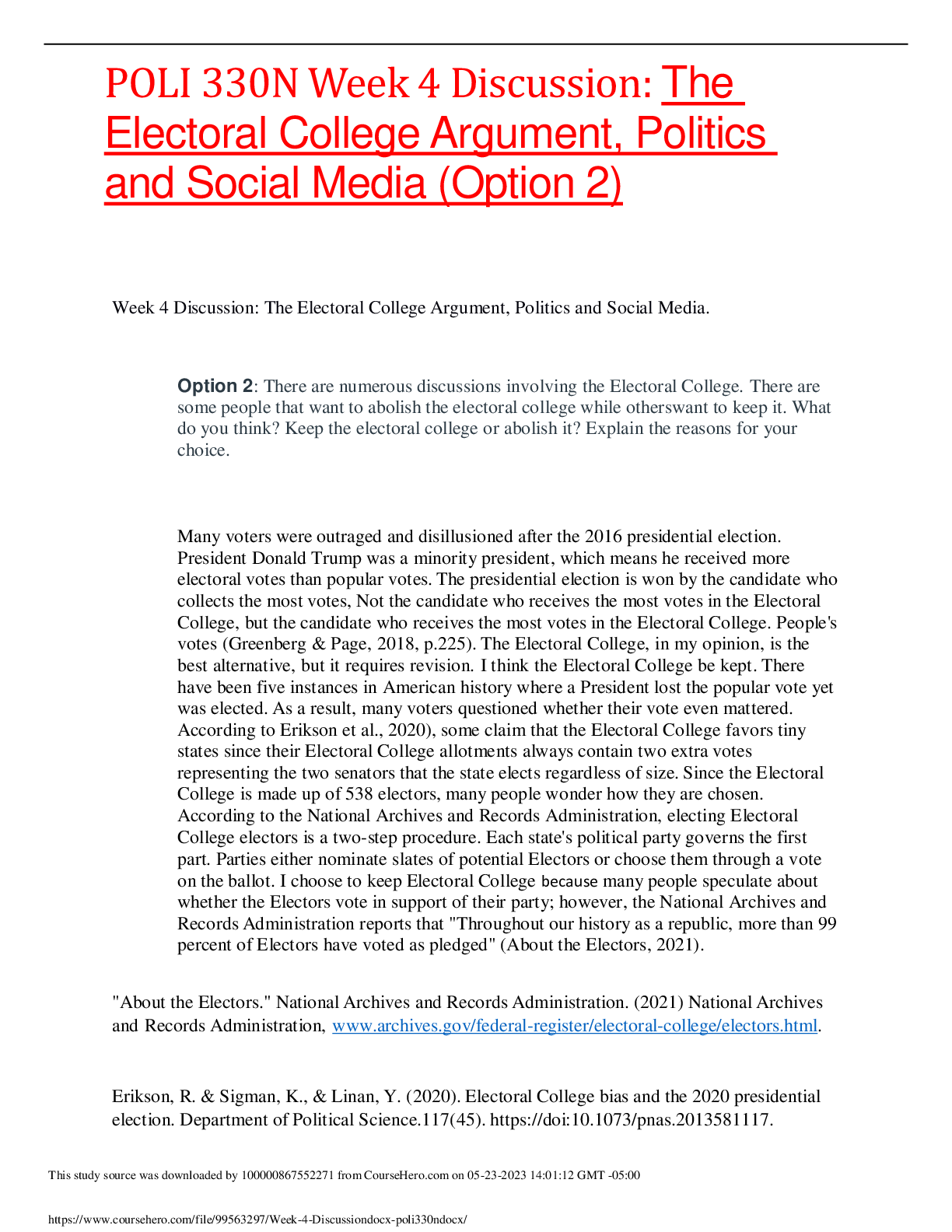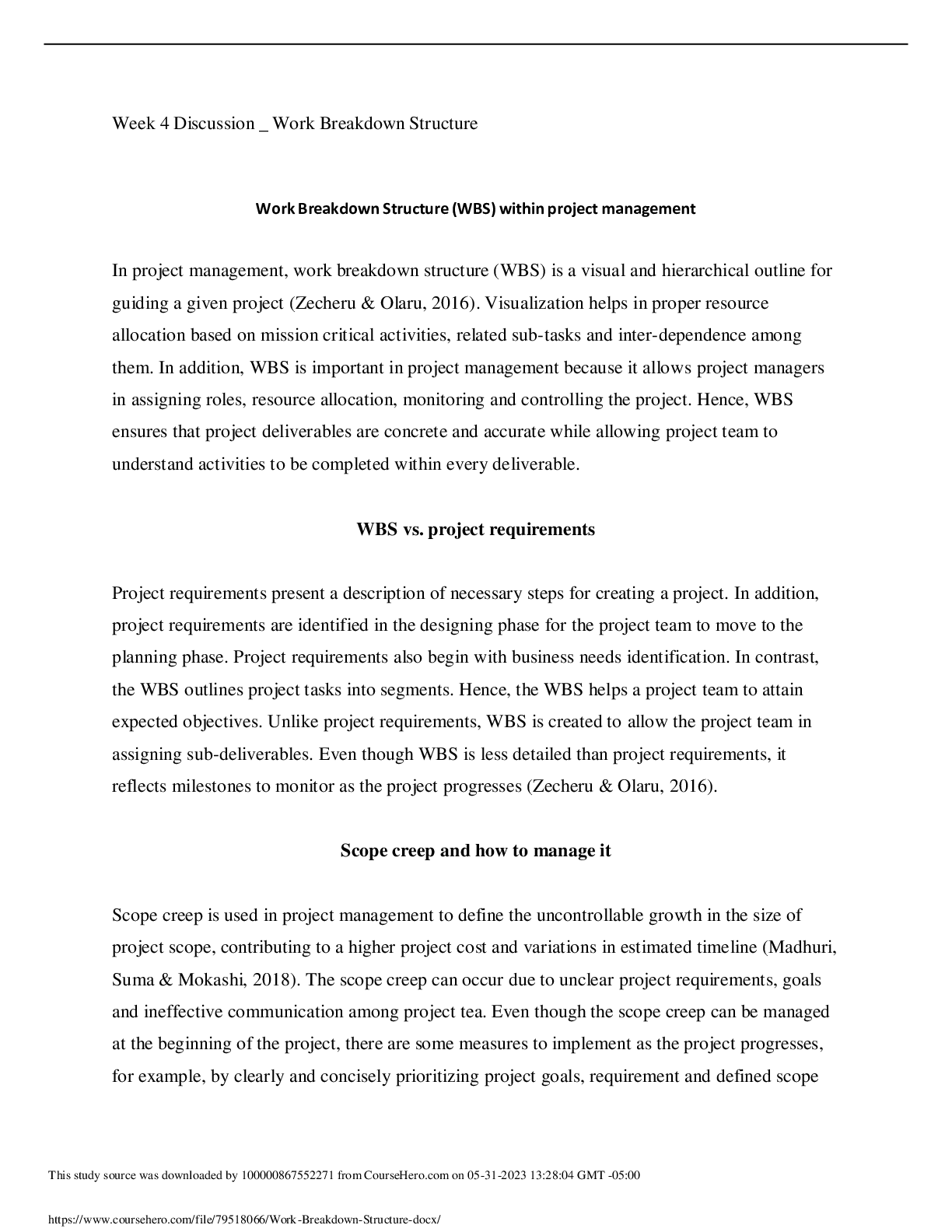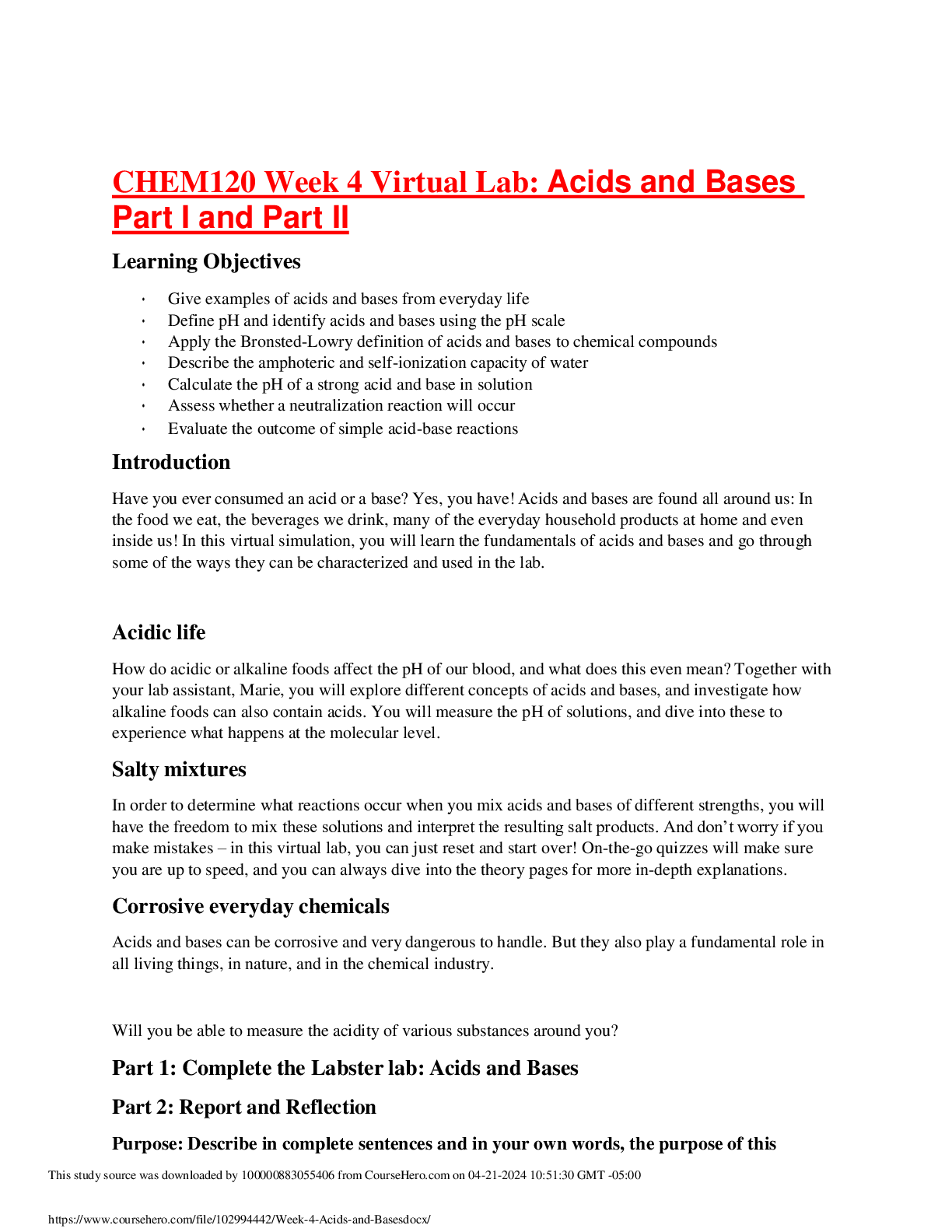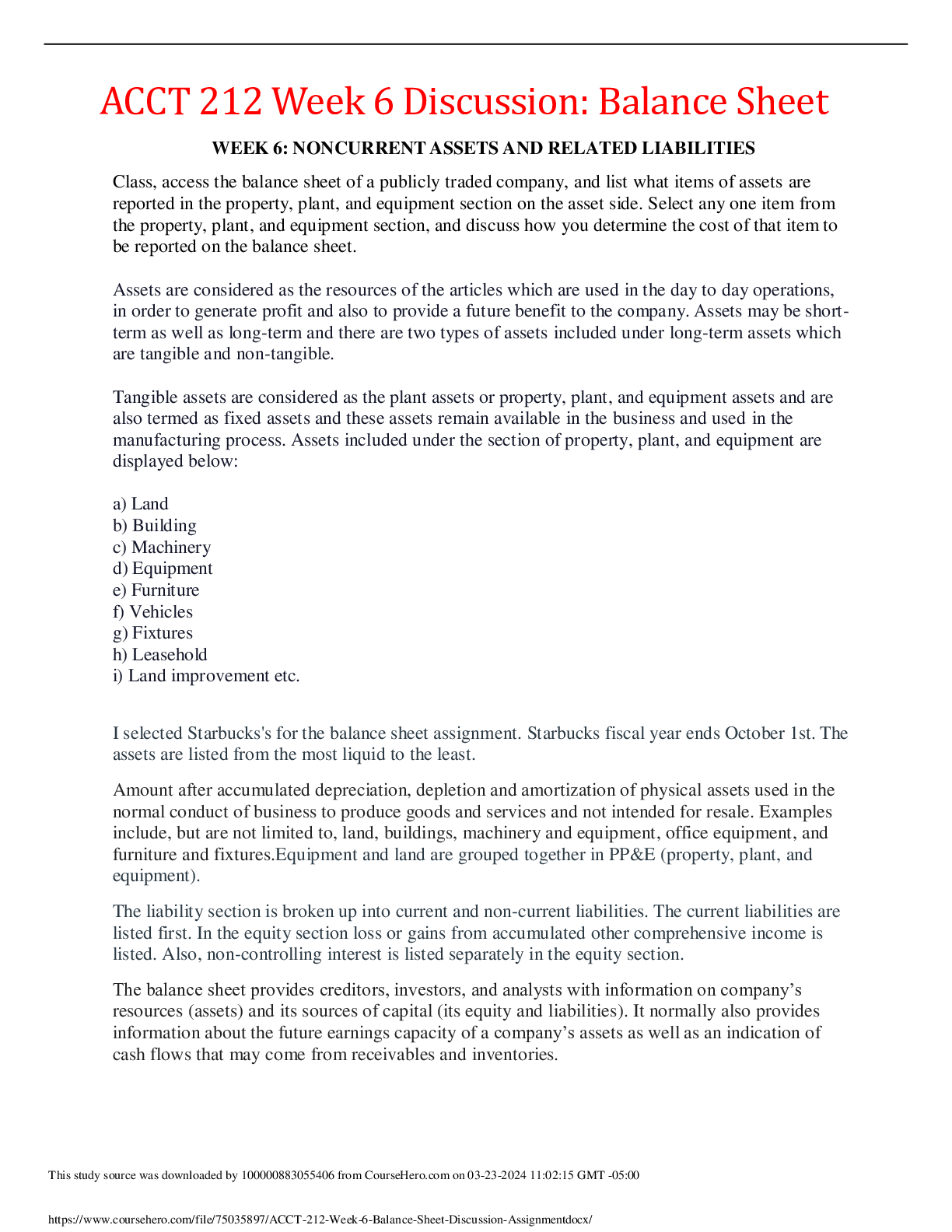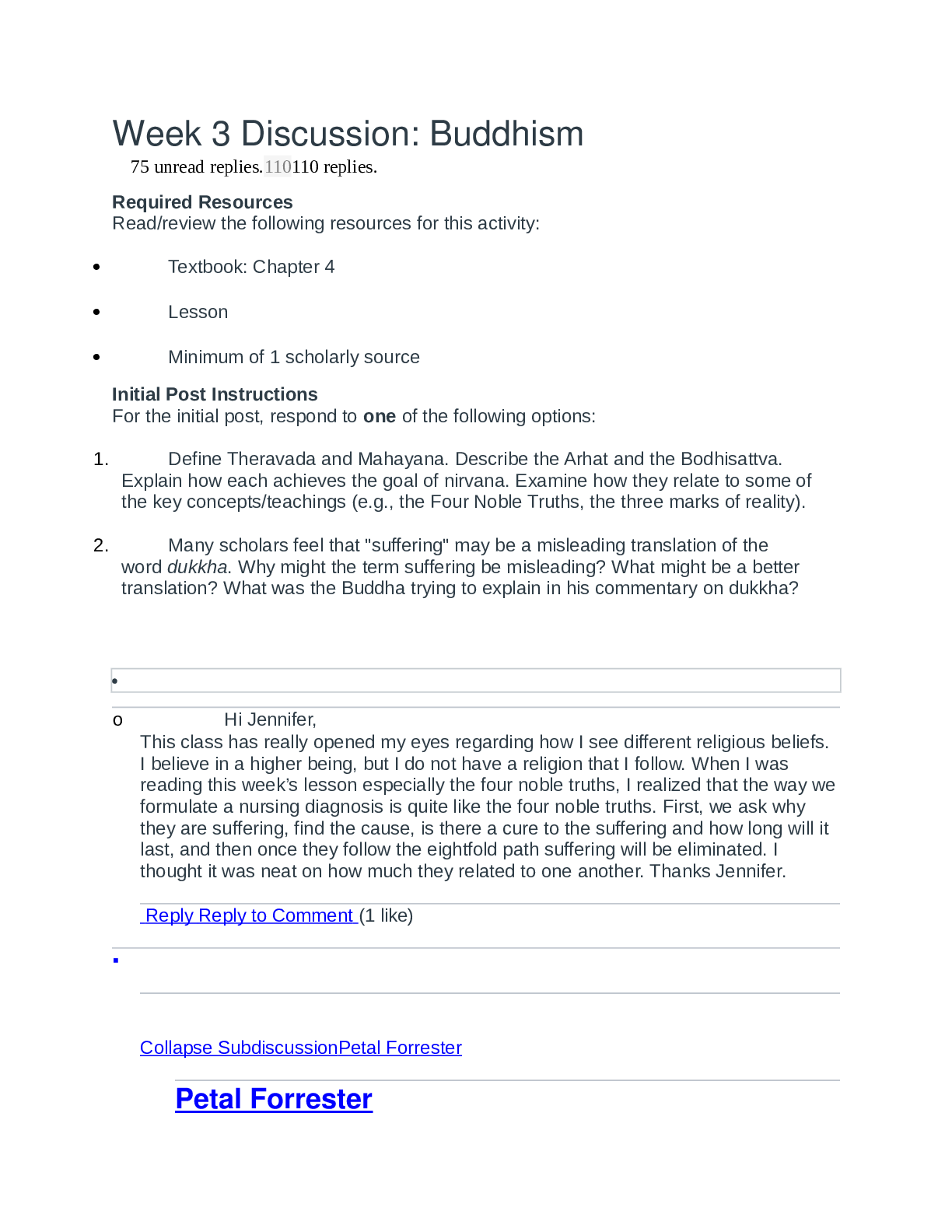Religious Studies > DISCUSSION POST > RELI-448N Week 3 Discussion: Buddhism - Different Discussions Well Explained (All)
RELI-448N Week 3 Discussion: Buddhism - Different Discussions Well Explained
Document Content and Description Below
RELI 448N Week 3 Discussion: Buddhism Required Resources Read/review the following resources for this activity: • Textbook: Chapter 4 • Lesson • Minimum of 1 scholarly source Initial... Post Instructions For the initial post, respond to one of the following options: 1. Define Theravada and Mahayana. Describe the Arhat and the Bodhisattva. Explain how each achieves the goal of nirvana. Examine how they relate to some of the key concepts/teachings (e.g., the Four Noble Truths, the three marks of reality). 2. Many scholars feel that "suffering" may be a misleading translation of the word dukkha. Why might the term suffering be misleading? What might be a better translation? What was the Buddha trying to explain in his commentary on dukkha? Manage Discussion Entry Hello Professor and class, Buddhism According to Wikipedia Dukkha is a term found in ancient Indian literature, meaning anything that is "uneasy, uncomfortable, unpleasant, difficult, causing pain or sadness". It is also a concept in Indian religions about the nature of life that innately includes the "unpleasant", "suffering," "pain," "sorrow", "distress", "grief" or "misery." The term Dukkha does not have a one word English translation, and embodies diverse aspects of unpleasant human experiences. It is opposed to the words sukha, meaning "happiness," "comfort" or "ease.” This includes physical and mental sufferings birth, aging, illness, dying; distress from what is not desirable (2018). There is no one single word that fully translate the word dukkha in Pali into English. Dukkha is used to include a range of suffering from mild frustration to horrible suffering (Molloy, 2015). Another word that I believe could be used instead of suffering would be sorrow or unhappiness. The Buddha believed life lived conventionally comes with the inevitability of change, thus it can never be fully satisfying. Life is ever changing, happiness, youth, wealth, prosperity constantly changes, none of these things last forever. Wealth, prosperity, happiness all changes, fluctuating or passing and death is inevitable. Buddha view life as inescapable experience of sorrow and dissatisfaction. Buddhism examines the types and causality of suffering in order to overcome it since it is inescapable. Buddhist goal is to respond appropriately by utilizing the Four Noble Truth and the Eightfold Path in order to overcome suffering. The noble truth is the chain of truth regarding life: 1) suffering exists; 2) it has a cause: 3) It has an end and ; 4) one can be released from suffering by following the Noble eight fold path. To live is to suffer and suffering is due to desires or cravings, always wanting something else or more, discontent, dissatisfaction or misery, to end suffering is to end desire and attainment of Buddhism’s ultimate goal nirvana. Nirvana is the extinguishing of the fires of desire, attaining complete self-control, end to karma, rebirth. To attain nirvana Buddhist believe in following the Noble Eightfold including all the eight rights, understanding, intention, speech, actions, works, effort, meditation and contemplation (Molloy, 2018). Buddha made it his aim to identify, explain and end human suffering using the Four Noble Truths as a method to adopt a diagnostic format to explain suffering and its cure; the 1st Noble Truth identifies the disease, the 2nd provides etiology, the 3rd gives a prognosis, and the 4th suggests a remedy. Buddhism is returning to this life, one’s own little life, with new attitude, a better person, calmer, more aware, someone without envy, greed or hatred with the knowledge that nothing is forever and grief is a price we pay for love, allowing oneself to enjoy life, who has given up envy and greed and hatred and such, who understands that nothing is forever, that grief is the price we willingly pay for love. Today the Western world has realized the psychological essence of Buddhism. Aich T. K. (2013). Buddha philosophy and western psychology. Indian journal of psychiatry, 55(Suppl 2), S165-70.doi: 10.4103/0019-5545.105517 (Links to an external site.)Links to an external site. Retrieved from https://www.ncbi.nlm.nih.gov/pmc/articles/PMC3705677/ (Links to an external site.)Links to an external site. Molloy, M. (2013). Experiencing the World's Religions. New York, NY: The McGraw- Hill Companies, Inc. (Links to an external site.)Links to an external site. (Links to an external site.)Links to an external site. Wikipedia Dukkha Retrieved from https://en.wikipedia.org/wiki/Dukkha Manage Discussion Entry Professor and Class, Theravada is the first branch of three of Buddhism based on the teachings of Buddha (Siddhartha after enlightenment). Several schools in the early centuries of Buddhism claimed to adhere to the unchanged, original and conservative teachings of Buddha. The school named Theravada is the name of the one school that has survived to present. Theravada is used today to refer to the entire movement. The heart of Theravada is the monks. Theravada means “the way (vada) of the elders (thera).” The continued goal of Theravada monks was to pass on the teachings of Buddha in oral form, but they eventually wrote them down. In Theravada, Buddhism arhat is a “perfect being” that has reached nirvana through detachment, desirelessness, and meditation and the life of a monk is the superpath to nirvana. In Theravada Buddhism, no layperson can attain nirvana. Monks live by the Buddha’s teachings called Vinaya, that rules for monostatic life such as eating and begging interactions with others. The Second Noble Truth: Suffering Comes from Desire is the idea that suffering comes from desires and from not being happy with what one has. The lifestyle that the monks keep with, unworldly living, minimal dress, shaven heads and begging for food, one can visualize them practicing the Second Noble Truth. Mahayana is the second branch of Buddhism. Mahayana translates to “big vehicle” that refers to the broad scope of vision that can accommodate a wide variety of people seeking enlightenment. “Mahayana also stresses that enlightenment is a call to compassion, for “the Mahayana tradition maintains that a person must save himself by saving others” (Molloy, 2013). Mahayana teaches that everyone can attain nirvana, not just monks. In Mahayana Buddhism, a bodhisattva (enlightenment being) is a person that embodies compassion or empathy (karuna). “Bodhisattva renounces Nirvana in order to spend eons upon eons of rebirths serving the needs of all sentient beings and vowing to withhold one’s own attainment of Nirvana until all other beings attain it first” (Feldmeier, 2018). The Third Noble Truth: To End Suffering, End Desire can easily apply for the layperson to aim for inner peace by accepting peacefully what occurs rather than looking to attain happiness. Dukkha is the third characteristic of the reality of life. The word dukkha is a Pali (ancient Indian languages) word with no real accurate English translation. Dukkha is often translated as suffering but it’s meaning might be limited through translation (Teasdale & Chaskalson, 2011). Dukkha is the central focus of the Four Noble Truths. The first two truths which deal with the origin of dukkha and the third and fourth the cessation of dukkha. Buddha “analyzed the nature and causes of suffering much like a doctor would diagnose an illness—in order to understand and overcome them” (Molloy, 2013). Dukkha might be better translated in the English language if it included pain and suffering. Pain-both mental and physical and suffering to encompass more of the feelings associated frustration and disappointment and as for how we relate to the stressful situations, that Buddha teaches is part of life. Patients may experience dukkha during times of illness and injury. It would be essential for a nurse to have knowledge dukkha and how it is interpreted by not only the patient but also of the family involved, to be able to advocate for them during these situations Martha References: Feldmeier, P., PhD. (2018). Emptiness, bodhisattvas, and meister eckhart.Buddhist - Christian Studies, 38, 187-201. Retrieved from https://chamberlainuniversity.idm.oclc.org/login?url=https://search-proquest- com.chamberlainuniversity.idm.oclc.org/docview/2132187595?accountid=147674 (Li nks to an external site.)Links to an external site. Molloy, M. (2013). Experiencing the world's religions (6th Ed.). New York, NY: McGraw-Hill Higher Education Teasdale, J. D., & Chaskalson, M. (2011). How does mindfulness transform suffering? I: the nature and origins of dukkha. Contemporary Buddhism, 12(01), 89- 102. o Manage Discussion Entry “sorrow” and also means “dissatisfaction” or “disease”. As Molloy states, “life, when lived conventionally, can never be fully satisfying because of its inescapable change” (Molloy, 2013, p. 132). Life continuously is changing and through changes it can bring, “death, divorce, sickness, fire, flood, earthquake, war, and loss of job or home” (Molloy, 2013). There is no clear escape from suffering, however it depends on the individual experiencing it and how they respond to it. In the article it is stated that “The goal of Buddhism is to awaken and realize one’s true nature, which puts an end to dukkha” (Loy, 2014, p. 39). When one realizes that things will change, however everything will be okay that is when dukkha “suffering” is put to an end. Molloy (2013) states the Four Noble truths are the following: suffering exists, has a cause, has an end and there is a way to attain release from suffering. Many feel the translation of “suffering” may be misleading for the term dukkha. The term “suffering” may be misleading for the word dukkha due to not all change leads to suffering. One must take the change and refocus it to provide a benefit in the individual’s life. A translation that may fit the term dukkha better would be “transition”. As one transitions through life one changes or improves from one state to another. A transition allows for growth and change, and yes I believe that suffering may be felt at certain obstacles life throws in the direction of an individual however it is a chance to grow from that situation. As life may bring misery to a person, such as a death or divorce, the person suffers however their life changes to accept the dukkha “transition” that has occurred. References: Loy, D. R. (2014). Why Buddhism and the Modern World Need Each Other: A Buddhist Perspective. Buddhist-Christian Studies, (34), 39– 50. https://doi.org/10.1353/bcs.2014.0027 (Links to an external site.)Links to an external site. Molloy, M. (2013). Experiencing the world's religions (6th ed.). New York City, NY: McGraw- Hill Companies, Inc. Sincerely, o Collapse SubdiscussionMichelle Coyne Manage Discussion Entry According to Buddhism, one of the three marks of reality is dukkha. “Du” meaning vile, uncomfortable or unfavorable. “Kha” meaning empty, emptiness or unreality (Hayes, 2016). When translated, dukkha means “suffering” or “sorrow” and “dissatisfaction” or “dis-ease” (Molloy,2013). Dukkha covers all that we understand by pain, illness, disease, physical and mental suffering, including minor forms of discomfort, disharmony, limitations, frictions, or in a philosophical sense, the awareness of incompleteness or insufficiency (Hayes, 2016). One may say that the Buddhists’ focus on suffering as hopeless and dark, but what others do not see is the hopeful purpose of this focus. For many of us, suffering is something we would like to prevent or avoid. The Buddha lived a sheltered life at the palace. He felt dissatisfied with this life, so he left. That is when for the first time in his life he witnessed suffering. After that, he set out to find the truth about suffering. After many years of dedicating his life to the problem of suffering, he began to teach the 4 Noble Truths. In this part of his life, he focused on the cessation of suffering. He taught that suffering is a part of life and no one can escape it, but each person can decide how to respond to it. Dukkha may translate to suffering, but the Buddha encourage people to deal with it and the outcome may be one of hope and enlightenment. I cannot think of another word that would be appropriate to replace suffering. Dukkha happens to everyone, every day. The key to overcoming it is based on how we deal with it. Sometimes we do not have the strength to take on suffering. Suffering is not resolved overnight. It may take time. Buddha’s teaching about suffering and the cessation of suffering brings to mind the phrase “there is light at the end of the tunnel”. Suffering may seem hopeless, but by following the 4 Noble Truths, suffering can lead to positive outcomes one can learn from. Hayes, C. (2016). Is suffering Therapeutic? An exploration of Buddhist ideas and Rogers’ six conditions. Person-Centered & Experiential Psychotherapies, 15(3), 245–255. https://doi- org.chamberlainuniversity.idm.oclc.org/10.1080/14779757.2016.1188411 (Links to an external site.)Links to an external site. o Collapse SubdiscussionGreg Salyer Manage Discussion Entry According to our book, “It is impossible to know exactly what the Buddha taught. He did not write down his teachings, nor did his early disciples. The only written versions were recorded several hundred years after his death, following centuries of being passed on orally—and of being interpreted in multiple ways. We must rely on the basic trustworthiness of both the oral traditions and the many written texts that pass on his teachings” (Molloy, 2013, p.129 ). Facts could have changed over time with oral teachings being passed on from one generation to the next. Important details could have been elaborated, omitted, or changed completely over time. An article I read on Buddhism in America states, “Towards the end of the 2000s, ‘mindfulness’ emerged as a significant buzzword in and around mainstream Buddhist communities ... In general, the term ‘mindfulness’ in American Buddhism signifies an awareness of the interconnectedness of mind, body, and environment and the meditative techniques to cultivate it in spiritual practice and social action” (Crosby, 2014). I think there is a movement towards our culture here in the United States to want to gain a mindfulness state through the increase in yoga, holistic healing, and meditation practices. I, personally, have gained such peace through my own quest of meditation and a sense of just being. I thoroughly enjoy reading on Buddhism and its history and place in today’s world. According to Encyclopedia Britannica, Dukkha, (Pāli: “sorrow,” “suffering”), Sanskrit Duhkha, in Buddhist thought, the true nature of all existence. Much Buddhist doctrine is based on the fact of suffering; its reality, cause, and means of suppression formed the subject of the Buddha’s (Links to an external site.)Links to an external site. first sermon (see Four Noble Truths (Links to an external site.)Links to an external site.). Recognition of the fact of suffering as one of three basic characteristics of existence—along with impermanence (anichcha) and the absence of a self (anatta)—constitutes the “right knowledge.” Three types of suffering are distinguished: they result, respectively, from pain, such as old age (Links to an external site.)Links to an external site., sickness, and death; from pleasure changing to pain; and from the fact that, because of impermanence, beings are susceptible to pain in the next moment” (britannica.com). I think the term “suffering” can be misleading because of what we as a society consider suffering in today’s age. Suffering according to the Buddhist belief is what is before one reaches enlightenment. There is struggle and hardships all throughout life, whether you are an ant or a king. Maybe a better phrase for today’s understanding would be simply “it’s just life.” People understand that life can be hard, and in an effort to get through struggles, we must try and better ourselves after each hardship so we can learn for the next hurdle. Michelle “Dukkha,” Encyclopedia Britannica, retrieved January 22nd, 2019 from https://www.britannica.com/topic/dukkha Molloy, M. (2013). Experiencing the World’s Religions, Tradition, Challenge, and Change (6th ed.). New York, NY: McGraw-Hill. “The Birth and Spread of Buddhism,” Ancient Civilizations, retrieved January 22nd, 2019 from http://www.ushistory.org/civ/8d.asp o Manage Discussion Entry Hello Professor and Class, * Theravada "The Way Of The Elders" is a form of Buddhism that is found mostly in Sri Lanka and Southeast Asia ( Molloy, 2013). * The second great branch of Buddhism is called Mahayana, a word that is usually translated as “big vehicle.” It suggests a large ferryboat in which all types of people can be carried across a river, and it hints at the broad scope of the Mahayana vision, which can accommodate a wide variety of people seeking enlightenment (Molloy, 2013). *Arhat is the ideal of practice in Theravada and in Mahayana Buddhism, the idea of practice is the bodhisattva. According to our text, Arhat is a person who has practiced monastic disciplines and reached nirvana, the ideal and the ideal in Mahayana Buddhism is the person of deep compassion, the bodhisattva (“enlightenment being”). Because a bodhisattva embodies compassion, it is often said that a bodhisattva will refuse to fully enter nirvana, to be reborn on earth to help others. A person may even take the “bodhisattva vow” to be continually reborn until all are enlightened ( Molloy, 2013). *According to Molloy 2013, The ultimate goal of Buddhism is nirvana. Nirvana consists of these things: the end of suffering, inner peace, and liberation from the limitations of the world. Upon attaining nirvana, the individual has self-control, no rage or emotional forces from outside by the unpredictable events of life. Nirvana is also believed to end karma and rebirth after the present life. *Due to the ultimate goal of Buddhism being Nirvana, The four nobles of truth ties in with Nirvana because Nirvana goals are to end suffering, have inner peace, and no limitations from the world. It's the same concepts as the four nobles. The four nobles are simply to live is to suffer, suffering comes from desire, to end suffering, and to be released from suffering (Kang, 2011). Arhat and Bodhisvatta also tie in with the four nobles because they are forms of Buddhism with the same ultimate goal. o Collapse SubdiscussionKhrystyna Voronko Manage Discussion Entry Hello Professor and Class, Theravada and Mahayana are major Buddhism tradition that shares the same core beliefs and devotion to the life and teaching of Buddha. They do however have some differences which differentiates them. According to this week’s lesson, Theravada means 'Way of the Elders' in Pali, the original language of the teachings (Chamberlain College of Nursing, 2019). Theravada Buddhism is closer to the original Indian form of Buddhism, and is associated with South East India and Sri Lanka. Mahayana Buddhism on the other hand spreads north through Tibet, China, and Japan for example. Mahayana which means ‘Great Vehicle,’ rejects the personal quest for enlightenment, instead their approach to Buddhism embraces the idea that enlightenment must be universally shared by all sentient beings (CCN, 2019). Therefore, Mahayana promotes the idea that believers/followers should not just seek personal enlightenment but the enlightenment of all beings. Arhat is the name given to individuals who are deemed worthy. The early teaching of the Buddha is known as tripitaka (three baskets), individuals who achieved Liberation or Nirvana through these practices and teachings were called arhats (CCN, 2019). Theravada Buddhists places great emphasis on arhat and is considered to be an important goal of a Buddhist, as they aim to gained true insight in the true nature of existence and would therefore achieve Nirvana. On the other hand, Bodhisattva which means ‘enlightenment being’ is given greater prominence in Mahayana Buddhism (Holmes, 2017). Bodhisattva has deep compassionate (Karuna) care for others, and therefore those practicing Mahayana Buddhism beliefs that because a bodhisattva embodies compassion, he will refuse to fully enter nirvana, in order to be reborn on earth to help others (Molloy, 2013, p.147). Due to the strong infinite compassion, the Bodhisattva would give up their own nirvana to help others achieve it. Both Theravada and Mahayana share common basic Buddhist teachings of Four Noble Truths, Eight-fold path. Early Buddha teachings were revolved around the Four Noble Truth, which formed the foundation for other teaching and practices overtime. The Theravada Buddhism noted that any individual who mastered the teachings were called arhats, the worthy ones. This teaching further formed the basis for new teachings and new approaches for Buddhism, as it is believed by Buddhists that nothing in the world is permanent. Key teachings of the Theravada include the belief that a seeker should gain insights from his own experience, application of knowledge, and critical reasoning. While on the other hand, Mahayana includes not just meditation and personal disciplines in their teachings but also selfless service and working in the world for the benefit of others (Robert, n.d.). Reference o Collapse SubdiscussionGreg Salyer Manage Discussion Entry Professor and Class, This week our text talks about the three marks of reality in the Buddhist Religion. The third characteristic dukkha is often interpreted as suffering. This is a Pali word that really doesn't have a good English translation (Teasdale and Chaskalson, 2011). Our text says dukkha is most easily translated as suffering, sorrow, dissatisfaction, or dis-ease (Molloy, 2013). Because of how misleading the translation is many people choose not to translate it at all and just use the term Pali term dukkha(Teasdale and Chaskalson, 2011). Dukkha is also the central focus of the four truths that include: to live to suffer, suffering comes from desire, to end suffering, end desire, and release from suffering is possible and can be attained by following the noble eight-fold path. My thoughts on what Buddha was trying to convey when speaking of dukkha would more or less mean things happen, good and bad that cannot be prevented, they just are and with that comes feelings that can be overcome. We crave or thirst things we don't have instead of just being happy with what we have. We choose to let these situations effect us and they can cause use pain, sorrow, and longing. According to Teasdale and Chaskalson, Budda said "‘There is dukkha’—this is just how it is for all of us. We do not need to take it personally—it’s not me, it’s not my fault but the normal unawakened human condition" (Teasdale and Chaskalson, 2011, p. 91) I believe that a better translation would be emotion or feelings related to any situational or life experience that do not bring us peace. It is a feeling of unacceptance and not being satisfied. I read a comment to an online discussion where someone stated their interpretations was "any sound that is present when all you want it to be completely quiet" (Burrman, 2015). This really stuck with me. There is no scholarly backing behind it, just a simple comment with so much meaning that I felt described this concept well. references Burrman, J. (2105, February 21). Re: Translations of Dukkha [Web log comment]. Retrieved from https://www.quora.com/What-are-some-translations-of-dukkha org.chamberlainuniversity.idm.oclc.org/10.1080/14639947.2011.564824 Manage Discussion Entry Many scholars feel that "suffering" may be a misleading translation of the word dukkha. Why might the term suffering be misleading? What might be a better translation? What was the Buddha trying to explain in his commentary on dukkha? Hi Class and Professor, In our text they define duhkha as, suffering, sorrow, dissatisfaction, or disease. Even in joy and pleasure, you can never be fully satisfied because it will always be accompanied by pain and suffering. (Molloy, 2013). I do believe the word suffering is misleading however. I like the definition in Contemporary Budhism better, “It notes that suffering comes from the Sanskrit term "dukkha/duhkha" which could literally mean bad situation”(Peacock, 2008). In my research I found that Buddhism has three types of defined duhkha, “the threefold division into explicit suffering(duḥkha- duḥkhatā), the suffering of change(vipariṇāma-duḥkhatā), and conditioned suffering(saṃskāra-duḥkhatā)” (Harris, 2014). I can really identify with viparinama- dukhata. I am a person who really really hates change and has a very hard time with it. Many people wouldn’t really say change is a part of suffering but I would for sure. I think the translation of “bad situation” is a much better translation. Using the example in our text of the happiness of buying a new car but the present reality of car payments shows us the always present suffering. But, while driving that beautiful new car, and paying those payments, no one would say that was suffering. People are happy with the new fancy car because it’s what they want, so they will deal with the payments. If it was true suffering people wouldn’t do it. But, the payments could be the “bad” part of the scenario. Not suffering. So, with this First Noble Truth, that to Live is to Suffer is partly true, as well all know and see on the news every day the sad reality that people are suffering, but not every joy and happiness in life is accompanied with suffering. Harris, S. E. (2014). Suffering and the Shape of Well-Being in Buddhist Ethics. Asian Philosophy, 24(3), 242–259. https://doi- org.chamberlainuniversity.idm.oclc.org/10.1080/09552367.2014.952931 Molloy, M. (2013). Experiencing the world's religions (6th ed.). New York City, NY: McGraw-Hill o Manage Discussion Entry Hello professor and class, According to dictionary definition of Buddhist Dukkha is the first of the Four Noble Truths, that all human experience is transient and that suffering results from excessive desire and attachment. Usually translated as “sorrow” or “suffering” in Buddhist thought Dukkha is “the true nature of all existence” (Britannica.com) Buddhism sees recognizing facts of suffering as one of three characteristics of existence (right knowledge), along with other two characteristics impermanence (anichcha) and the absence of self (anatta). Three types of suffering are separated: old age, sickness and death. Our life’s can never be fully satisfying because of changes that happen constantly to our everyday life. Human beings always worry about something from people we love, daily stress, bills, sickness etc. “The Buddha concluded that to live means inescapably to experience sorrow and dissatisfaction.” (Molloy,2013) But the focus of Buddhism on dukkha is to analyze the nature and cause of suffering. “Indeed, no one can escape suffering, but each person can decide how to respond to it, as indicated in the Four Noble Truths” (Molloy,2013) Reference: Dukkha Buddhism. Retrieved from: https://www.britannica.com/topic/dukkha (Links to an external site.)Links to an external site. o [Show More]
Last updated: 1 year ago
Preview 1 out of 15 pages
Instant download

Buy this document to get the full access instantly
Instant Download Access after purchase
Add to cartInstant download
Reviews( 0 )
Document information
Connected school, study & course
About the document
Uploaded On
Jun 13, 2023
Number of pages
15
Written in
Additional information
This document has been written for:
Uploaded
Jun 13, 2023
Downloads
0
Views
40


